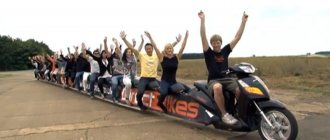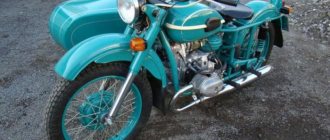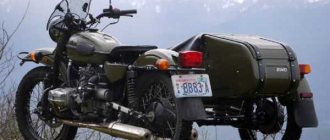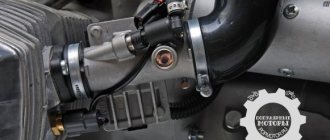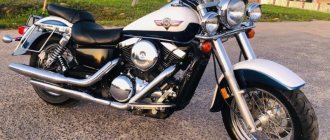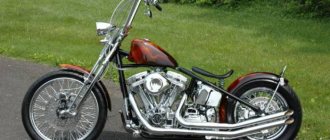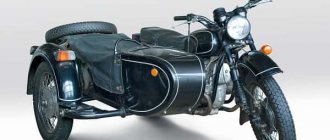The Ural Solo motorcycle, produced back in the 90s, was a slightly redesigned version of the regular IMZ-8.103-10 , only in a single-seat version. This bike, equipped with 650 cc engine, was even supplied to the traffic police (then traffic police), and police officers rode it in the warm season. At the beginning of the 2000s, it was replaced by the Ural Solo Classic with a 750 cc engine , the same one that was installed on the Wolf and Voyage, but it was not too popular. Later, Ural Solo ST and Ural Retro Solo were created, but both were designed primarily for the markets of other countries. Some enthusiasts purchased these models in Russia, but there are only a few of them. And not least because of the high price of these motorcycles, partly due to the use of imported components.
Design
The vintage appearance of the Solo model will not leave any lover of two-wheeled classics indifferent. However, there were some flaws, and incomprehensible voids, coupled with carelessly laid wires, which are visible even in the photo, cause bewilderment - such shortcomings are not surprising when buying budget Chinese motorcycles, but not a modern “opposite”, at a price comparable to some not too old "Japanese".
Specifications
The first Ural Solo motorcycles were equipped with an ancient 650 cc 40-horsepower engine, but they are still rarely found on sale. Subsequently, the technical characteristics were improved, and the motorcycle received a 750 cc engine, which was installed on the Ural Solo Classic. At the same time, the bike acquired Brembo brakes , a Japanese carburetor and a host of other imported components.
Engine
boxer engine has not undergone any significant changes over the past two decades, with the exception that in the Ural Retro Solo and the Ural Solo ST it received an injector instead of a carburetor. The engine is powered by 92-octane gasoline and accelerates the bike to 100 km/h in about 10 seconds , reaching a top speed of 120-140 km/h . One of the pleasant moments is the confident traction at the bottom, and the less pleasant ones are the weak dynamics. This disadvantage is especially felt on the highway.
Transmission
The ancient 4-speed transmission has remained virtually unchanged for the past sixty years. The first three gears are relatively short, so you can switch to the top one at 60-70 km/h. Interestingly, the fourth gear ratio is greater than one, which is unusual for most cruisers. But there is a reverse direction! Although on a motorcycle without a sidecar like the Ural Solo Classic it is not really needed.
Chassis and brakes
The frame, rear suspension and driveline have not changed at all over the years. Brembo brakes on the front wheel , and the Ural Retro Solo, together with the Solo ST, can boast a similar braking system at the rear. The front fork, imported and reliable, has become much better; compared to the Ural Solo Classic, it’s just heaven and earth! The motorcycle stopped nodding when braking, and the efficiency of the front suspension was equal to the efficiency of the brakes.
Electronics
The Japanese Yuasa battery , a microprocessor ignition system from Ducati and a 500-watt generator have been installed on the motorcycles of the Irbit plant since the end of the 20th century. If the wiring had also been carried out wisely, and not left the wire harnesses hanging out where they would fall during assembly, it would have been absolutely wonderful.
Weight and dimensions
The motorcycle weighs 200-220 kg , depending on the modification, and subjectively it seems even lighter due to the low center of gravity. The relatively short wheelbase and the steering wheel, which is not too wide by cruiser standards, make it easier to control, and all the instruments are located where logic dictates they should be. In the city, the Ural Solo of any modification feels no worse than on the highway.
Controllability
The bike handles decently, better than you might expect from it. This is partly due to the short wheelbase and proper weight distribution, and partly to the small fork angle. At the same time, when driving at high speed, the motorcycle behaves obediently and predictably, as befits a cruiser, albeit a vintage one.
Fuel consumption
Real (and not declared by the manufacturer) fuel consumption is about 7.5 liters per 100 km . Considering the substantial volume of the gas tank, 19-22 liters depending on the modification, this is enough to cover considerable distances without refueling. But at maximum speed, gasoline consumption increases, and very significantly.
Interesting Facts
| This section is an unordered list of various facts about the subject of the article. Please bring the information into an encyclopedic form and distribute it to the appropriate sections of the article. As decided by the Wikipedia Arbitration Committee, lists should preferably be based on secondary, aggregated authoritative sources that provide criteria for inclusion of items in the list. |
| External images |
| Motorcycles "Ural" in Iraq |
- In 2002, Saddam Hussein's Republican Guard ordered 2,000 Ural motorcycles with sidecars to support their defensive strategy based on high mobility tactics. Officially, the motorcycles were intended for the Iraqi Ministry of Health and Ministry of Agriculture. About 1,500 motorcycles were delivered before the start of the Iraq War as part of the Oil-for-Food program, which aroused great interest among the military and the public. However, after the overthrow of Saddam Hussein's regime, the State Transport Company of Iraq, which entered into an agreement on the supply of motorcycles, was forced to look for other buyers. According to Iraqis, motorcycles with sidecars are well suited for moving around the city and off-road. Due to the ongoing violence and the danger of coming under fire at any moment on the street, the Iraqis weld additional protection on the vulnerable spots and sidecar of the Urals and install a machine gun on the motorcycle. Representatives of the American command in Iraq have repeatedly expressed concern about the appearance of such motorcycles with machine guns among Iraqi rebels.
- The new generation Russian Ural motorcycle took part in the filming of the film “Ghost Rider 2”.
- In December 2013, at the last stage of the Olympic torch relay of the 2014 Winter Olympic Games in the city of Kamensk-Uralsky, 11-time Russian motocross champion Evgeny Shcherbinin carried the torch on a Ural motorcycle, and on February 8, 2014, 20 Ural motorcycles took part in opening ceremony of the Olympic Games in Sochi.
- In November 2022, the Ural Brand presented a prototype of the Ural electric motorcycle with a sidecar. The prototype was created on the basis of the existing ST chassis with single-wheel drive. The motor, battery, controller and other components are from the famous American manufacturer of electric bikes Zero Motorcycles. The manufacturer's management later revealed some plans for the electrical project.
Repair and tuning
The strength of Soviet motorcycles has always been its maintainability. Years have passed, but nothing has changed in this regard. Fortunately.
Repair
Repairing a motorcycle on your own is not difficult, especially for a rider with a garage, tools and straight arms. In addition, new models require attention much less often than older ones, and generally do not show a tendency to sudden breakdowns.
Spare parts
The Irbit Motor Plant supports all the equipment produced in recent years, so you can buy any spare parts, and the company has dealers, at least in large cities. But many spare parts are out of stock and will have to be purchased to order. Waiting times can be long. But the owners of the Ural Solo Classic motorcycle of the early 21st century will face all sorts of torments of hell, because most of the parts for this bike are unique, and finding the necessary spare parts is now extremely difficult.
Tuning
Boxer fans are used to modifying their bikes. But who would dare to cut up a vintage retro motorcycle with an angle grinder? There is no tuning as such for this model, and everything else is the machinations of the cunning Chinese from Aliexpress.
Advantages and disadvantages
This model is not without its disadvantages. But for true fans of retro style, they all overlap with how the bike looks, how it sounds and what it is all about.
Advantages
- Overall thoughtful design , attractive and memorable.
- High quality of most parts, especially on Solo ST and Retro Solo.
- Powerful low-end traction , like a real cruiser.
Flaws
- Weak suspension . This is not relevant for Retro Solo and Solo ST - the chassis is in perfect order there.
- High fuel consumption . The gas tank is, of course, spacious, but gasoline does not become cheaper over the years.
- 4-speed gearbox , ancient as a mammoth.
- Assembly flaws such as not fully tightened bolts and wires hanging in sloppy “snot”.
Convenience
Ural Solo sT is equipped with two transformable seats: standard single-seat solutions have rubber-covered seats or 2-seater motorcycles.
You can also choose two single seats.
First of all, this modern motorcycle is designed for comfortable movement on asphalt surfaces.
However, it can easily cope with movement on the roads of villages or in the absence of a road.
It handles the track quite confidently and is highly stable when cornering.
The motorcycle has excellent aerodynamic characteristics.
Manufacturers have provided the motorcycle with excellent shock absorption, so small bumps on the road are practically not felt.
A perfect braking system adds a high degree of safety to this vehicle. Especially when maneuvering along city streets.
An excellent Kawasaki Versus 650 motorcycle, designed for long trips, both on highways and on rough and mountainous terrain.
The design of this bike from Kawasaki, even taking into account the time that has passed since the creation of the motorcycle, is considered very fresh and ultra-modern.
Owner reviews
A noble spender, he bought his Retro Solo in 2014 on order, and chose the option with maximum chrome. It should be noted that they really didn’t skimp on the chrome, and the quality is good. There are no complaints about the motorcycle, it was serviced by a dealer, and drove about 13 thousand km three years before the sale. During this time, I replaced the brakes with reinforced ones, since the original hose had stretched, and that’s all, the rest is just maintenance. Roman, Moscow.
I bought a 2003 motorcycle second hand in 2016, in the condition “it was in the garage for 5 years, but all the rubber bands dried out, and the rats ate the wiring.” Over the winter I got everything in order and started driving. The impressions are mixed - there seems to be a delight from the correct iron opposition, but the regular jambs that Uralych throws in somewhat spoil the overall impression. Maybe everything is fresher and better in the models, I don’t know, I’ve only seen them in pictures. Ilya, Krasnogorsk.
I owned the Solo ST for one season, didn’t like it, sold it. Before that I drove a Kawasaki W800, the Japanese one is head and shoulders better in all respects, I regretted selling it twenty times. The style is the same, vintage in all fields, only in Kavu you just need to fill up with gasoline and change the oil sometimes, but with this boxer you need to check every time before a trip to see if the oil has leaked out of it. Well, this kind of romance, it’s better to ride on “soulless rice” and not worry about anything. Georgy, Novorossiysk.
History of Solo first issues
I would like to tell my story of communication with the opposition, which has been going on for more than 14 years. During this time, I gained experience in the repair and maintenance of Ural Solo motorcycles.
I started riding, like probably many others, on a Minsk, then on an Izha, and on Czech motorcycles. At the same time, having mastered one class of motorcycle, if opportunities allowed, I tried to switch to a more powerful one, but always of domestic production, because... I was frightened by the high cost and low maintainability of foreign cars, poor suitability for our roads.
As soon as the first Solos went on sale in our stores (around 1993), I immediately had a desire to buy, but I didn’t have the required amount. There was also no repair experience, so I bought an Izh Planeta-5 and drove it for several years, but the thought of a heavy, powerful single vehicle never left my head. Interest was also fueled by articles from the Moto magazine for 93-94, which talked about the operation of these motorcycles.
These motorcycles went on sale in scanty quantities and were approximately two to two and a half times more expensive than the Izhi.
And once, when I was driving my “Planet-5” along the highway on a long, rather steep climb at a speed of about 70 km/h in 3rd gear, such a “Solo” easily passed me without straining. At a glance, his speed was about a hundred. This impressed me because... “Izh” was not capable of this.
Finally, I had the opportunity to buy a used Solo for an inexpensive price. The deciding factor for the purchase was the low price. The motorcycle was running, but had been in an accident and was quite damaged. The impression from the first trip was twofold. On the one hand, it’s a heavy and quite comfortable motorcycle, on the other, there are short gears (in fourth, after 75 km/h, the revolutions are already too high. After 90 km/h, the engine is already overturning.) In addition, there was quite a strong vibration on the steering wheel, which is strange for a boxer , which is well balanced in design.
I enthusiastically began to master the hardware and gain practice. Having put the mechanics more or less in order, the appearance, which was very important to me, still remained, to put it mildly, not very good, and its restoration required a lot of money. So I decided to look for another motorcycle, in better condition.
I managed to find the same, almost new “Solo”, with a mileage of 6 km. Their release date coincided (February 1994). But the motorcycle stood for 9 years in the basement, not properly preserved, with cylinders damaged by corrosion.
Therefore, I had to repair the CPG and tidy up the appearance. At the gearbox I installed the fourth accelerated one (1.19).
I tried to make a motorcycle suitable for long trips, because... I love asphalt long-distance driving. But, even with an accelerated fourth gear, I set the rear axle to ten (10/35), because Without it, when driving on the highway, the engine still twists.
Fears that the engine would not be able to pull the entire transmission were not confirmed. A standard, well-adjusted, unworn 650cc motor pulls the whole thing along just fine. The dynamics did not drop critically. The only thing is that it takes longer to accelerate in third.
But after three and a half thousand runs, 3 teeth of the driven Chinese gear, which was overheated, broke off at the root. The gearing was adjusted perfectly.
Returned to the factory nine. (I haven’t found a quality top ten yet.)
The combined accelerated transmission (fourth plus ten) left an indelible impression on me personally. It was as if it was designed for this motorcycle.
In 1969, even the smallest BMW R 50/5 with a 500 cm engine and 32 hp. had a top speed of 157 km/h. (Moto magazine, October 2004.) Therefore, why can’t a Ural with a 650 cc engine and the same power, but more torque and at lower speeds, have the same performance? He has them.
The appearance of the motorcycle differs little from the stock one. The original wind shield may not be very elegant, but in terms of wind protection it is very effective. Knee guards (I installed them made of stainless steel) and guards on the steering wheel also work as wind protection.
Even at speeds above 100 km/h, all the air flow comes from above, so the motorcycle is pleasant to ride over long distances. You don’t get tired when driving for a long time; with well-synchronized standard K-65T carburetors, vibrations are small and do not tire.
After 90 km/h, the boxer wakes up and is able to express itself. In total I drove it about 17,000 km, I didn’t go far, maximum 150 km. During this run, NOT A SINGLE BREAKDOWN HAPPENED, EVEN MINOR! With the exception of the aforementioned overheated Chinese ten. The plans are to install the top ten again, hang good side panniers, and put on good imported tires.
Similar models
- Triumph Bonneville T100 . A British take on the classics. It's expensive, but the price is justified.
- Kawasaki W650 . A vintage Japanese bike in the best traditions of half a century ago, but with true samurai quality.
- Moto Guzzi V9 Roamer . A stylish guy from sunny Italy, with a transverse V-twin and the inimitable charm of a real gentleman.
FAQ
- Are spare parts still available for Solo ST and Retro Solo? Or maybe they fit from other modern Urals? Spare parts are produced at the Irbit plant, but they are rarely available. Often you have to order and wait. Some units are suitable from brothers in the model range.
- Do new bikes not have the problems that ancient boxer bikes are so famous for? Compared to the products of the Irbit plant of Soviet times, the new models are much more reliable, this is an indisputable fact.
- Why are they so expensive? In general, why buy a boxer at the price of a Japanese or American motorcycle? Because they are sold, with rare exceptions, only in the markets of other countries. Only connoisseurs of the brand buy them from us.
Ural Solo sT – motorcycle classic
The modern motorcycle Ural Solo sT continues the classic traditions of the Ural, which has been produced since the times of the Soviet Union.
The model that is based on it comes with stainless exhaust pipes , a standard fuel tank, a tractor-style saddle, and a black fender at the rear.
It has a classic black finish .
But when ordering this motorcycle, the buyer is offered the opportunity to order additional equipment for the model to upgrade the standard equipment.
Conclusion
The old Ural Solo Classic is an affordable opportunity to join the domestic classics, while avoiding much of the fuss that is inevitable when buying a very ancient “opposite”. And fresh copies of recent years of production differ from them for the better even more, and the archaic design in them is adjacent to good quality. This is “Ural” in the form in which it could have been from the very beginning, if the issue of its production had been approached with full responsibility. This does not change the fact that this is an extremely outdated piece of equipment in terms of technical characteristics, and one can only recommend buying it to an opposition fan who is nostalgic for the old days.
Specifications
| Maximum engine power: | 45 HP |
| Working volume: | 750 cm3 |
| Motor type (cylinder arrangement, number of strokes): | Boxer OHV, 4-stroke |
| Number of cylinders: | 2 |
| Number of valves: | |
| Intake type (Injector / Carburetor): | |
| Bore and stroke: | |
| Starting system (Electric starter, kick starter): | |
| Maximum speed in km/h: | 140 km/h |
| Cooling system: | Air |
| Transmission (gearbox): | 4-speed, with reverse |
| Clutch (Dry / Wet): | |
| Drive unit: | Cardan |
| Frame: | Steel |
| Chassis | |
| Suspension (front/rear travel): | |
| Brakes (Front/Rear): | |
| Wheels / Tires / Rubber: | |
| Dimensions and weight | |
| Dimensions (Length / Width): | |
| Seat height: | |
| Ground clearance: | |
| Curb weight: | |
| Weight: | 234 kg |
| Fuel tank capacity: | 19-22 liters depending on the engine modification. |
| Battery capacity: | |
| Year of release: | |
| Country of Origin: |
017_moto_0312_014
RESULT. That was hard. At times it's even too risky. But IMZ, it seems, achieved exactly what he wanted and what no one believed in. “Ural” is no longer associated with the collective farm and the pioneers. Today it can be considered a full-fledged motorcycle.
| "Ural-Retro" (manufacturer's data) | |
| COMMON DATA | |
| Model year | 2011 |
| Dry weight, kg | 325 |
| Length × width × height, mm | 2224 × 1630 × 1020 |
| Base, mm | 1570 |
| Ground clearance, mm | 125 |
| Seat height, mm | 750 |
| Gas tank volume, l | 22 |
| Steering column tilt angle, degrees. | 30 |
| Reach, mm | 66 |
| ENGINE | |
| Type | B2, 4T |
| timing belt | OHV, 2 valves per cylinder |
| Working volume, cm³ | 749 |
| Cylinder diameter × piston stroke, mm | 78 × 78 |
| Compression ratio | 8,6:1 |
| Supply system | carburetors Keihin L 22 AA, diffuser Ø32 mm |
| Power, hp at rpm | 40/5600 |
| Torque, Nm at rpm | 51,5/4500 |
| Cooling system | air |
| Starting system | electric starter |
| TRANSMISSION | |
| Clutch | double disc, dry |
| Transmission | 4-speed, reverse gear |
| main gear | cardan shaft |
| CHASSIS | |
| Frame | tubular, steel |
| Front suspension | Paioli telescopic fork |
| Pipe diameter, mm | 40 |
| Wheel travel, mm | 125 |
| Rear suspension | pendulum with two Sachs shock absorbers, adjustable spring preload |
| Wheel travel, mm | 80 |
| Brake system | separate |
| Front brake | disc, Ø295mm, 4-piston Brembo caliper |
| Rear brake and side trailer brake | drum |
| Wheels | spoked, aluminum rims |
| Front tire | 4×18 |
| Rear tire | 4×18 |
OWNER'S OPINION. Vitaly “Bordo” Borovsky: “Retro” is my second “Ural”. The first, a classic Troika model wheelchair, served me faithfully for seven seasons and traveled 40 thousand km on the roads of 24 countries. It never let me down and proved to be a reliable and completely modern motorcycle. Therefore, the purchase of a “Retro” with a stroller was a completely conscious and purposeful decision, and its main purpose, as before, was traveling on asphalt for several thousand kilometers - “Retro” is ideal for these purposes.
The new motorcycle has a different frame, significantly lower than the classic one. As a result, Retro feels low, sleek, and light to me. It steers much easier, there is practically no roll, it holds a straight line as if on rails, and the effect of a right turn with the lifting of the cradle comes much later. Where on a regular Ural I leaned as far as possible to the right, pushing my butt into the sidecar, on a Retro I drive without leaving the seat. Driving is now even more fun and requires much less physical effort: even after a thousand kilometers I don’t feel like I’ve unloaded a wagon of coal. Other impressions are more subjective, but no less stable. If my first “Ural” still seemed like a Soviet motorcycle with characteristic squeaks and rattles, then “Retro” creates a feeling of some kind of foreign-made solidity and reliability. And how elegantly a large headlight with an ignition switch looms before your eyes, from which a key sticks out like a sight!
Another big advantage of the “Retro” is the possibility of solo use, because it is already equipped at the factory with everything necessary: a side stand, a full set of turn signals and a side trailer electrical wiring connector. Being also the owner of a Harley-Davidson motorcycle, I can’t help but compare. “Retro” seemed to me light, small and nimble (and this is a “heavy Russian motorcycle”!). In traffic jams I felt like I was on a scooter: I climbed into all the cracks, steering with just my fingers. The ergonomics are familiar and comfortable, unlike the Harley scheme with separate turn signals, which also turn off themselves. The suspension is soft and comfortable. The road is familiar to the bumps - where I was shaking terribly on the Harley, I instinctively tensed up in advance, but nothing happened. So, “blah blah”, but I don’t even waver. During rides in the pouring rain, the motorcycle never sneezed - the new air filter no longer floods. Only on cleared asphalt, due to the thin wheels, the motorcycle behaves quite nervously. But I’ll probably change the mufflers: the original ones are very quiet.
As a result, my “Retro” is two wonderful motorcycles in one. With a sidecar, it is not only ideal for long journeys with a passenger and luggage, but can also give a lot of special pleasure to the experienced sidecar pilot - one who understands. In the solo version, I got a dynamic, maneuverable and elegant “old school” motorcycle, which I could use to get to work in traffic jams or to show off on Observation Street in the evening.
Rev'It!, Motto and Marushin equipment is provided by the PRO Moto store.
Black and white: “Ural-Retro”
